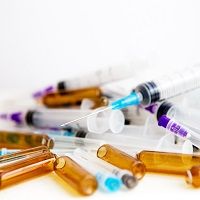Article
Assessing the Risk and Benefits of Testosterone Replacement Therapies
Author(s):
A research review concludes that older men who receive testosterone replacement via injection may enjoy greater benefits and face fewer risks than those who use transdermal or oral testosterone formulations.

A research review concludes that older men who receive testosterone replacement via injection may enjoy greater benefits and face fewer risks than those who use transdermal or oral testosterone formulations.
The authors of the new paper, a pair of researchers from the VA Medical Center at the University of Florida, referenced 96 published studies in an effort to compare the safety and efficacy of various testosterone products that physicians can choose for older patients.
They found that injections increase muscle and bone strength significantly more than oral or transdermal testosterone. The study authors also concluded, though with less certainty, that testosterone delivered by injection may be associated with fewer adverse cardiovascular events than testosterone delivered through the skin or the mouth.
“A possible explanation for the latter phenomenon is that transdermal testosterone causes greater elevation of serum dihydrotestosterone, due to significant expression of 5α-reductase in skin, but not in muscle,” they wrote in the American Journal of Physiology—Endocrinology and Metabolism.
“Meta-analysis of existing randomized placebo-controlled trial is, to date, insufficient to definitively assess the cardiovascular effects of testosterone replacement therapy. However, existing data exhibit trends indicting 1) that testosterone replacement therapy may not accelerate underlying early-stage prostate cancer 2) that transdermal testosterone replacement therapy may cause cardiovascular risk and 3) that intramuscularly injected testosterone replacement therapy may cause cardiovascular benefit.”
All forms of testosterone replacement increase muscle mass and strength by increasing the cross-sectional area of both type I and type II muscle fibers. The effect, however, is dose dependent. At low doses, testosterone’s main effect is to prevent protein degradation. At higher doses, it actually stimulates the synthesis of new protein.
Applications of transdermal testosterone, though frequent, rarely provide the body more than 10 mg of the hormone per day. Injections of testosterone, on the other hand, typically provide 50 mg to 200 mg in a single dose delivered every 2 to 4 weeks. Patients get similar amounts of testosterone overall, but those who receive it in the smaller doses may never get enough at a time to stimulate much new protein synthesis.
Results from 10 randomized controlled trials that studied the effects of 12-or-more weeks of testosterone replacement (but no resistance training) on the strength of older men illustrated the stark difference. All 6 of the trials that used testosterone injections found a significant increase in the amount of weight that subjects could lift one time. All 4 of the studies that used transdermal medication found no significant strength increases.
A smaller number of studies that focused on bone density reached similar conclusions. Testosterone injections were almost always associated with significant increases in lumbar spine density (and sometimes hip density) but studies of transdermal testosterone often found no significant effect.
When the authors looked at the possible negative effects of testosterone replacement, they found no evidence that delivery method affected the chance a study would find reductions in HDL cholesterol or elevated risk of polycythemia, urinary symptoms and PSA increases.
On the issue of cardiovascular health, the authors noted the disagreement among recent retrospective studies about the overall safety of testosterone replacement. They also noted their own meta-analysis of 35 different randomized controlled trials that had linked testosterone replacement and cardiovascular health.
That last analysis found that oral testosterone significantly increases the risk of adverse events (relative risk [RR], 2.20; p = 0.015), while transdermal therapy produces a non-significant directional trend toward cardiovascular risk (RR = 1.27) and injection produces a non-significant directional trend toward protection (RR = 0.66).




